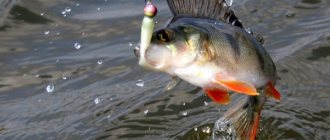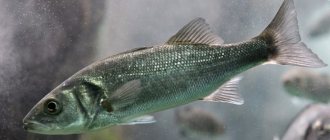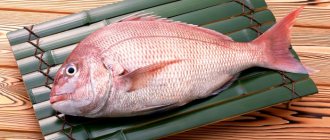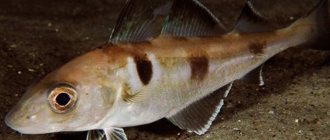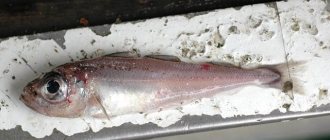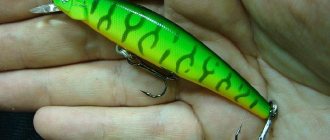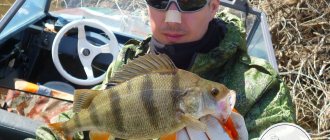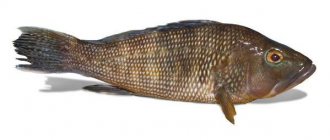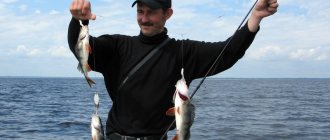As a result of research, ichthyologists have proven that man began to fish 750,000 years ago. This was one of the ways to provide themselves with food. His menu, among other fish, included sea bass, widespread throughout the world's oceans.
What do you prefer?
- Red fish 47%, 218 votes
218 votes 47%218 votes - 47% of all votes
- Crustaceans/molluscs 40%, 183 votes
183 votes 40%
183 votes - 40% of all votes
- White fish 13%, 61 votes
61 votes 13%
61 votes - 13% of all votes
Total votes: 462
18.04.2020
×
You or from your IP have already voted.
Appearance
Pacific species of perch are found mainly in coastal waters, while Atlantic species are found in bottom and deep-sea waters.
The color of sea bass is varied. The deeper the habitat, the brighter and redder it is. It's lighter in shallow water.
The mouth is large. The main weapon is the spiny rays on the dorsal, pectoral and anal fins, between which poisonous glands lurk. Their injections are very painful, the wound becomes inflamed, and the treatment takes a long time. For this, the perch received another name - “spiny-finned”.
In all the photos on the Internet, the perches look bug-eyed. This is not a vice, but a consequence of lifestyle. The deep-sea inhabitant is forced to adapt to the eternal twilight and, being a predator, also hunt in such conditions. Hence his lens-like eyes.
Interesting Facts
Redfish are long-lived. Although most live to be 60 years old, there are some individuals as old as 200 years old. Interestingly, this can be determined by otoliths (solid formations on the surface of cells) - age rings form on them, like trees.
We recommend reading: Catching chub with a spinning rod
Sea bass leaves offspring only when it reaches 10 years of age in the form of live fry, up to 1 million per season - this is an absolute record among viviparous fish. The fry stay near the surface, which is destructive for most of them.
One cabin boy from a nautical school described catching sea bass with a hook something like this. They were drifting south of Iceland (North Atlantic, Irminger Sea). Calm. I caught herring and mackerel with pieces from a depth of about 100 m. You lower the tackle for 6-7 minutes, take the line and immediately feel the weight, take 10 minutes to pick it out, unhook the fish, and the process repeats. No pleasure - I picked it up, put it down and so on until I got tired of it. Not only do you not have to wait for a bite and hook, but also due to the sharp change in depth, the fish’s air bubble falls out of its mouth by 10 cm - an unpleasant sight.
Dimensions
Representatives of different Sebastes species differ not only in color, but also in size. Some are small, barely reaching a length of 20 cm, others exceed 1 meter.
The largest individuals caught in Russia live in the Bering Sea. They grow more than one meter in length and weigh over 20 kg.
Reproduction
All sea bass are viviparous fish.
The eggs are not fertilized immediately, but some time after the male and female have mated. Embryos develop quickly. A large female can sweep out about 2 million larvae 5–6 mm long.
At first, transparent and inconspicuous fry adhere to the upper layers. As they grow up, they gradually descend lower into the bottom layers.
Juveniles live in areas where they were carried by the current in the first year of life, without making long movements. Significant migrations occur only upon reaching sexual maturity.
Features of the body of perches
Deep-sea fish withstand enormous ocean pressure. The swim bladder, into which gas is constantly pumped, helps them adapt to pressure.
To float, the gas must be released from the bubble. But the speed of release is slower than the speed of ascent (retrieving gear). With a sharp drop in pressure, decompression sickness occurs. Therefore, in perches lifted by a trawl into the upper layers, the eyes bulge, the stomach turns outward, and gas bubbles swell under the fins.
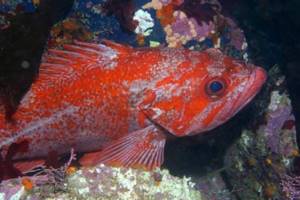
Golden sea bass (red) - Sebastes marinus
The golden sea bass has a laterally flattened body, bulging eyes, and a protruding lower jaw. The color is bright red - which is why it is called “red fish”. The belly is pink, all fins are orange-red and equipped with poisonous spines
Found in the northern part of the Atlantic from the coast of Norway to the Barents Sea.
In Russia they fish in the Barents and Norwegian seas, in the Far East.
Red predators live and hunt in small flocks at great depths, mainly on rocky soil covered with shells and silt. The largest concentrations of perch are observed when the water temperature is not lower than 2–3°C. They unite in large schools in the open sea when they go to spawn.
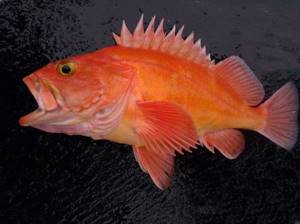
Useful properties and composition of sea bass

Meat composition
Sea bass meat contains all the necessary nutrients for normal human life. The same applies to other types of marine fish, and to be precise, this definition applies to almost all seafood.
Beneficial substances include:
- Phosphorus.
- Magnesium.
- Iodine.
- Chromium.
- Calcium.
- Zinc.
- Copper.
- Sulfur.
- Cobalt.
- Chlorine.
- Iron.
- Potassium.
- Manganese and other beneficial substances.
100 grams of sea bass contain 18.2 g of protein and 3.4 g of fat, while there are no carbohydrates at all.
Calorie content

Sea bass meat has very few calories. 100 grams of meat contains only 100 kcal, maybe a little more. During cold smoking, its calorie content drops to 88 kcal. 100 grams of boiled sea bass contains about 112 kcal, and if sea bass is fried, its calorie content will be about 137 kcal per 100 grams of weight.
Availability of vitamins
In addition to the most important microelements for the human body, perch meat contains a whole bunch of vitamins, such as:
- A.
- IN.
- WITH.
- D.
- E.
- RR.
On top of that, sea bass meat contains Omega-3 fatty acids, as well as taurine and protein, including the antioxidant myelin.
Medical aspect

From a medical point of view, the beneficial properties of perch are very extensive and cannot be overestimated. The presence of Omega-3 fatty acids allows you to normalize the metabolic process, as well as provide support for the body in case of prerequisites for diseases of the nervous system and cardiovascular system, while reducing cholesterol levels in the blood. It is advisable to eat sea bass for people with high blood pressure, as well as people with high blood sugar levels.
Taurine, which is found in fish meat, helps to activate the growth of cells, and above all, young and healthy ones, improving metabolic processes. Vitamin B12 has a positive effect on DNA synthesis in the human body.
Eating sea bass helps improve the condition of the skin and hair, and also calms the nervous system.
Medicine recommends eating sea bass for many categories of people, including pregnant women, children, teenagers and the elderly.
Fishing
The taste of the white meat of red fish is highly prized. Of all the fish in the world's oceans, perch is the most susceptible to fishing pressure.
Massive fishing began relatively recently, when bottom trawls began to penetrate to depths of 400-500 meters, where valuable fish mainly live. During the Soviet five-year plans, planned production rates were many times higher than the population, and trawls grossly destroyed underwater corals and sponges.
The number of perches in the Russian northern seas has decreased by at least 10 (!) times over 30 years. This fish becomes a “rarity” every year. Therefore, they are now catching much less, and they deliberately continue to reduce production in order to at least in this way maintain the number of this wonderful fish.
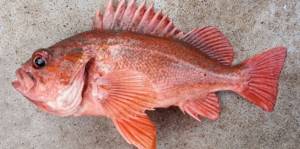
Norwegians, who are more environmentally conscious, carefully guard their mining secrets. There are still some Norwegian regions where, if the weather is favorable, the catch can be over 150 kg. Its price in the country is very high. It is also a subject of sport fishing skill.
Benefit
Golden perch is not only a tasty, but also a healthy fish. It is rich in minerals and vitamins, and contains the amino acid taurine, which is involved in fat metabolism.
Red sea fish is vital for those who have problems with blood vessels and heart - heart attacks, strokes, high cholesterol, arterial hypertension.
The iodine it contains helps normalize the proper functioning of the thyroid gland and endocrine system.
Eating sea bass meat by children protects them from rickets.
The meat remains fresh after being caught for 5-7 days in the refrigerator. But the frozen product does not lose its beneficial qualities.
Sea bass smoked, dried, salted
Among the recipes for cooking, not the least place in the cuisines of the world is occupied by smoked, salted and dried fish.
Sea bass processed using these methods has a number of features:
- The dried product, unlike the dried one, is soft. It is tasty, but a lot of salt is used for cooking, so fish can cause fluid retention and swelling. This perch has more calories than boiled or baked perch, since the water comes out of it, but the fats remain.
- Salted sea bass is tender and moderately fatty. It retains the main amount of useful substances, but its excessive consumption leads to edema and provokes kidney disease.
- Smoked perch is popular because it combines a pleasant taste and aroma. However, when cooked, carcinogens are formed in it, causing pathologies of the liver, kidneys, heart, blood vessels, and the formation of cancer cells. Of all types of product, smoked is the most harmful.
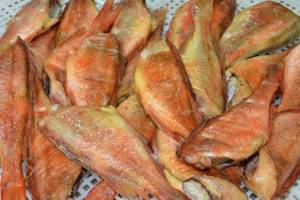
Aleutian sea bass – Sebastes aleutianus
Habitats:
- north Pacific,
- coast of the Kuril Islands,
- California,
- coast of eastern Kamchatka,
- in the Bering Sea, Gulf of Alaska.
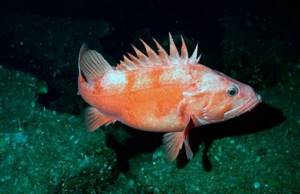
It got its name from the Aleutian Islands, where it lives in especially large numbers.
The Aleut looks intimidating even in the photo: along the massive body of a dirty red color there is a clearly defined red stripe. The belly is light and pink. The large head is studded with spikes, and a tubercle sticks out on the lower, forward jaw. There are 3-10 sharp spines around the eyes. Fins with dark edging.
Interesting fact. Aleutian perch is a long-lived sea fish. The most authoritative database of animal life expectancy today, AnAge, puts it in second place - 205 years, after the bowhead whale - 211 years.
Old-timers die not from old age, but only from the fact that with prolonged growth and increase in mass, their speed of movement decreases, as a result they cannot catch up with their prey or escape from another large predator.
Reference. The age of a fish is determined by the number of rings on its scales.
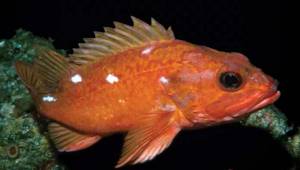
Habitat
Widely distributed in the North Atlantic Ocean and the Arctic Ocean:
- western part of the Barents Sea until the 35th century. d., off Western Spitsbergen, Greenland Sea, Norwegian Sea, off the coast of northern Norway, around Iceland and the Faroe Islands;
- off the coast of eastern and western Greenland;
- off the east coast of Labrador and Baffin Island;
- Baffin Sea, Irminger Sea, Labrador Sea;
- south along the coast of North America to Cabot Sound and Long Island.
Where is it found?
Sea bass are found everywhere, but they have favorite places. Fishermen know that a good catch can be obtained in Norway. At a depth of 200-300 m you can even find rare red snapper. There are many of them in the Atlantic Ocean and the North Pacific Ocean.
This fish is much more comfortable in cold waters. Sometimes it can be found at a depth of 900 m. The fish migrates in schools in the Norwegian and Arctic Oceans.
Is it grown artificially?
If sea bass is found on the shelves, 90% of it is caught from natural bodies of water. This fish is not artificially grown. The Lavrak species of perch began to sharply decrease its population, so they were forced to adapt it and breed it artificially.
Unnatural living conditions always affect the quality of fish.
Beaked perch (beaked perch) - Sebastes mentella
This species is a descendant of the northern Pacific grouper, which entered the waters of the North Atlantic through the Arctic more than a million years ago.
Beaked perch is a deeper-water and cold-loving fish compared to golden perch; it lives at depths from 300 to a maximum of 1440 m at a bottom temperature of 4–5 ° C.
The name is given for the strongly prominent growth at the tip of the lower jaw.
Habitat:
- Barents and Norwegian seas,
- coasts of Iceland and Greenland,
- California, coastal areas of North America.
Based on the location of distribution and appearance, the beaked fish is divided into Pacific and Atlantic.
The quiet perch has blood-red scales, the length of the fish reaches 55 cm, and the weight is 2.5 kg. Dive depth - 830 m, life expectancy - maximum 105 years.
The Atlantic beaked beak is smaller, never growing more than 50 cm. The scales are dark scarlet. The sizes are approximately the same. Lives longer than its relative.
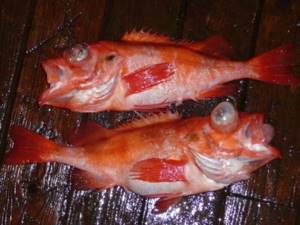
General description of the species
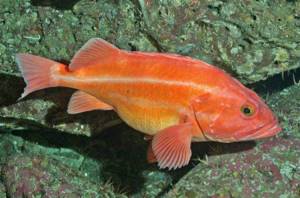
The head is large with crests, supraorbital and postorbital spines, a prominent lower jaw and scales. Unusually bright colors of pink, orange or red are found in fish that live in the upper layers of water. Deep representatives are characterized by a spotted-striped color. The eyes are large, saucer-shaped and adapted for bottom existence.
Red perch is fundamentally different from river perch in internal and external structure. They represent not only different families, but also belong to separate orders.
Important. There are poisonous glands on the fin rays, an injection of which causes local inflammation, which is quite painful.
The red snapper genus consists of 110 species, the most famous of which are the following:
- Aleutian dirty red in color with a pink belly and dark streaks along the back;
- Pacific beaked whale of the same color, but with 3 dark gray spots on the dorsal fin;
- brown of all shades with numerous dark inclusions;
- red striped pale pink or white with 4 vertical stripes;
- northern orange-red-pink palette;
- fiery or fiery - the name speaks for itself;
- oriental brown-violet shades and others.
Where are red snapper found?
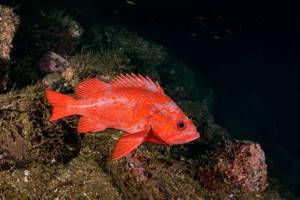
For the most part, the species live in northern and temperate Pacific waters, although the cape and ocellates prefer the southern waters of the Atlantic and Pacific oceans. 4 more species in the North Atlantic:
- deep-sea beaked whale or beaked whale;
- Norwegian;
- American or pink;
- small.
The greatest diversity of species (56) is found in the southern coastal waters of California. Depending on the species, sea bass are distributed from the tidal zone to a depth of 3 km in the bottom layers, regardless of the soil, but can also live in the pelagic zone (the zone not located close to the bottom). Benthic individuals live in algae thickets, occupying small areas and not moving over significant distances. Pelagic groupers migrate over long distances.
We recommend reading: How to distinguish a silver bream from a white bream quickly and accurately
Fishing is carried out along the northern coast of the Atlantic. The main fishing areas are:
- South and west of the Medvezhinsko-Spitsbergen Bank;
- Norwegian Sea;
- Iceland;
- Coast of New England (America).
And also the Barents Sea, the northern Kuril Islands, where perch can be caught all year round, but the greatest quantity is:
- April-June - in the southwest;
- August-November – western and central regions.
Amateur fishing is carried out from April to October, using monofilament fishing line with a cross-section of 0.85 mm and up to 10 hooks with a second groove on the shaft. Since fishing occurs from a depth of 150 m, it is necessary to use luminous beads as additional bait. Individuals weighing up to 5 kg are caught using shrimp, pieces of mackerel, and herring. For heavy weights of 5-15 kg, a floating wobbler, a red vibrotail, and a black twister are used. In Norway, from a depth of 200 m, perch is caught using a light-accumulating jig (oscillating spoon for vertical fishing) weighing up to 250-600 g.
What size does it reach?
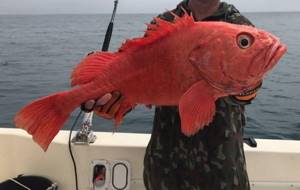
The largest one from the Bering Sea grows up to 1 m and weighs 20 kg. It is a species of the scorpionfish family. The smallest perches are only 20 cm.
On a note! Red snapper grows very slowly and matures late. Frozen headless carcasses of 25 cm each often arrive on store shelves, and their age is 15-25 years.
Since the fish stays in a narrow zone, they en masse fall into fishing trawls, from which they cannot slip out, since they have spines, spines and a flattened shape. Due to the slow development and maturation of individuals, the number does not have time to recover, so the population is steadily declining.
What does it eat?
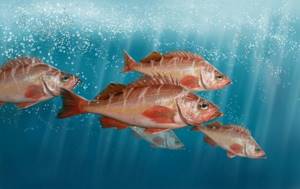
Benthic representatives of the species eat juvenile fish, large crustaceans and other invertebrates in the bottom layer. These individuals grab prey by abruptly jumping out of an ambush. In the pelagic zone, the migrating predator feeds on small fish and caviar.
Recommended reading: How to catch pike perch with a jig
